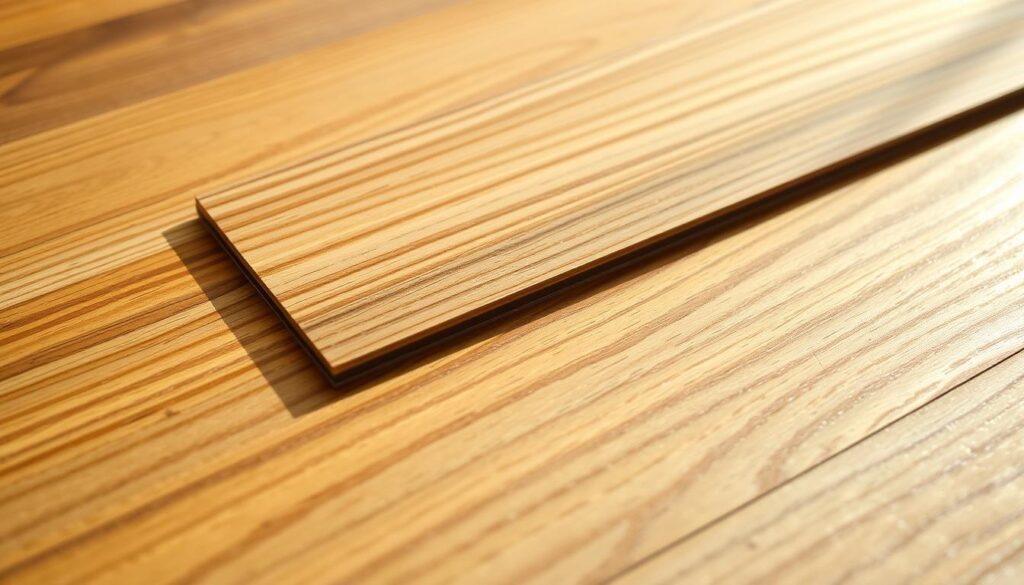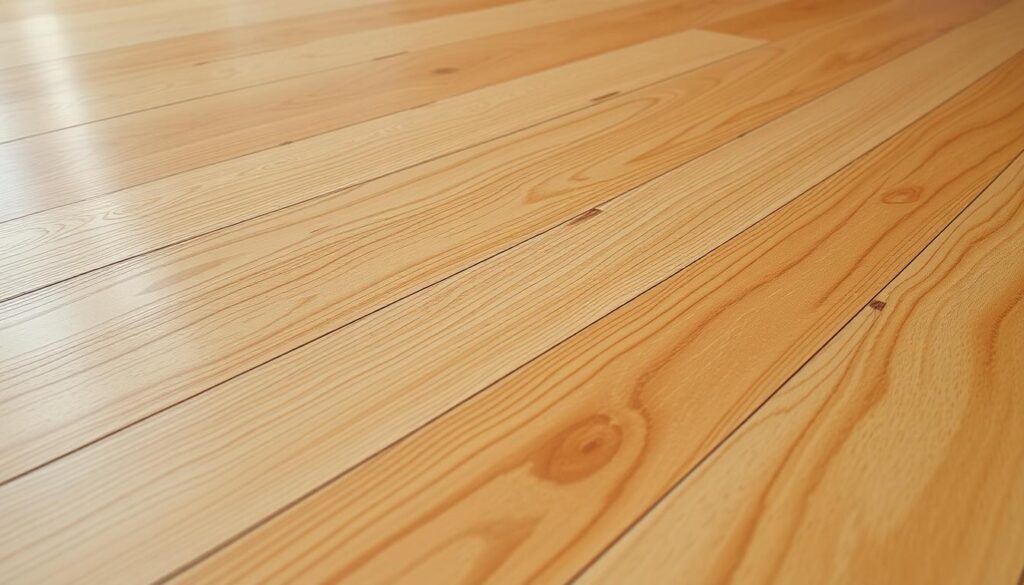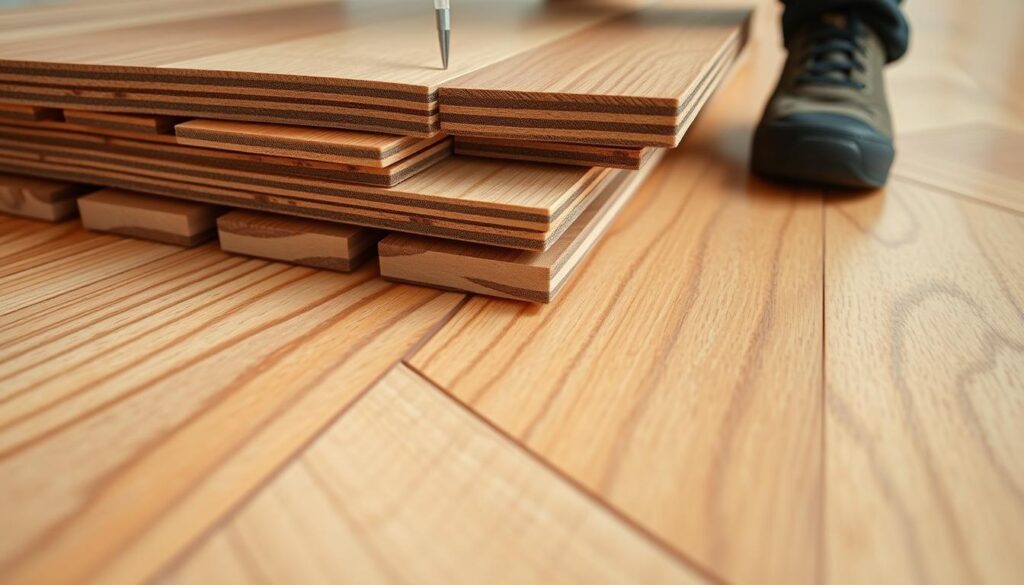5/8″ engineered hardwood flooring: 5 exceptional options for a beautiful, durable foundation in your living space.
Homeowners looking for the best flooring often choose 5/8 engineered hardwood. It combines the beauty of natural wood with extra stability. Unlike solid planks, it doesn’t warp or expand due to its layered construction.

The 5/8-inch thickness is just right for durability and flexibility. These floors are tough and easy to install in many places. Top designers pick this thickness for its ability to handle daily wear and tear, and for its refinishing potential.
The demand for durable flooring is rising as people see the value in quality materials. 5/8 engineered hardwood floors are not only beautiful but also last long. They’re perfect for living rooms, dining areas, and kitchens where solid hardwood might not work well.
Key Takeaways
- 5/8 engineered hardwood offers the perfect balance of beauty and durability
- Layered construction prevents warping and expansion problems
- This thickness provides excellent wear resistance for high-traffic areas
- Engineered wood flooring can be installed in areas where solid hardwood isn’t suitable
- Premium 5/8-inch options maintain refinishing potential over time
- These floors add significant value to homes while requiring minimal maintenance
Understanding 5/8″ Engineered Hardwood Flooring
Engineered hardwood is a big step forward in flooring. It combines beauty with practicality. The 5/8 inch thickness is perfect for durability and easy installation, making it a favorite in modern homes.
What Makes Engineered Hardwood Different from Solid Hardwood
Engineered hardwood and solid hardwood differ in how they’re made. Solid hardwood is one piece of wood, which can change with humidity. Engineered hardwood has a real wood top layer over layers of other materials, staying stable in different conditions.
This design lets engineered hardwood work in places solid wood can’t, like basements or over concrete. The top layer looks just like solid wood, but the base adds extra stability.
The Structure of 5/8″ Engineered Hardwood
Engineered flooring has three to nine layers. The top layer is high-quality wood veneer, giving it beauty and character. Below this is the core, often plywood, arranged in a way that prevents warping and keeps the floor strong.
This design makes the flooring very stable. The thickness of the top layer also decides how many times you can refinish it.
Why the 5/8″ Thickness Matters
The 5/8 inch thickness is ideal for engineered flooring. It’s durable but not as expensive as 3/4″ flooring. It’s thick enough to feel solid underfoot and can be refinished 2-3 times.
This thickness also helps with sound and works well with radiant heating. For those looking for a balance of quality and cost, 5/8 inch engineered hardwood is a great choice.
Benefits of Choosing 5 8 Engineered Hardwood for Your Home
The 5/8″ engineered hardwood is great for places with changing weather. It doesn’t expand and contract like solid wood does. This is because it’s made in layers.
This flooring is also good at handling moisture. You can put it in places like basements and kitchens. Solid hardwood can’t handle these conditions as well.
Video source from Youtube
With the right care, 5/8″ engineered hardwood can last 25-30 years. This is similar to solid hardwood but uses less wood. You can refinish it 2-3 times during its life.
Installing engineered hardwood is easier than solid hardwood. You can choose from floating, glue-down, or nail-down methods. This depends on your subfloor and what you prefer.
- Compatible with radiant heating systems
- Dimensional stability in varying humidity
- Less acclimation time required before installation
- Cost-effective compared to solid hardwood
- Environmentally friendly manufacturing process
| Feature | 5/8″ Engineered Hardwood | Solid Hardwood |
|---|---|---|
| Moisture Resistance | High | Low |
| Installation Options | Floating, Glue, Nail | Nail only |
| Subfloor Requirements | Flexible | Strict |
| Cost Range | $5-$10 per sq ft | $8-$15 per sq ft |
Oak Elegance: Premium 5/8″ Engineered Oak Flooring
Oak has been a favorite in American homes for centuries. It adds timeless beauty to many homes. The premium 5/8″ engineered oak flooring combines classic oak’s beauty with modern engineering. This makes it perfect for today’s homes.
Color Variations and Grain Patterns
Oak wood colors range from light honey-blonde to deep, reddish-brown. Each plank has its own story in its unique colors. Many makers offer stained options to highlight these natural tones while keeping the wood’s character.
Oak grain patterns add visual interest to your floor. The way the wood is cut changes its look:
- Plain-sawn oak shows dramatic flame-like patterns
- Quarter-sawn oak has striking ray flecks
- Rift-sawn oak has straight, consistent grain lines
Durability Features of Oak Engineered Flooring
Oak is very hard, with a Janka rating of 1290-1360. This makes it great for busy homes. The 5/8″ engineered construction keeps it stable, preventing warping from humidity changes. You can refinish it multiple times, making it last longer.
Best Rooms for Oak Engineered Hardwood
Oak engineered flooring looks great in living rooms, dining areas, and bedrooms. Its warmth adds comfort. It’s also good for hallways and staircases because it’s hard.
Its stable construction lets you install it in basements and over concrete. Many choose oak for open-concept spaces. It unifies different areas with a single flooring type.
Maple Magnificence: Smooth 5/8″ Engineered Maple Options
Engineered maple flooring is known for its elegance and performance. Its light color makes rooms feel bigger and brighter. This is especially good for small spaces where darker woods might feel too heavy.

Maple has a smooth, tight grain that looks clean and uniform. This makes it perfect for modern homes and still looks great in traditional ones. It’s also easy to keep clean because it doesn’t hold onto dust and dirt like other woods do.
Light wood floors made from maple have a Scandinavian look. They go well with both simple and bold colors. Maple can start as a creamy white to a pale golden, and special stains can make it amber or darker while keeping its grain.
Maple is very durable, with a Janka hardness of 1,450. This is higher than red oak’s 1,290. So, it’s great for busy areas like hallways and living rooms. The 5/8″ thickness gives it a solid feel without losing the benefits of engineered flooring.
| Maple Feature | Benefit |
|---|---|
| Fine, tight grain | Smooth surface texture, less dirt collection |
| Natural light coloration | Brightens spaces, versatile design compatibility |
| Superior hardness (1,450 Janka) | Excellent resistance to dents and wear |
| Minimal color variation | Consistent, uniform appearance throughout rooms |
Maple ages well, getting a warm golden patina. This adds depth and character to the floors over time. It does this without changing color too much, which can clash with other decor.
Hickory Resilience: Rustic 5/8″ Engineered Hardwood Choices
Hickory is a standout in engineered hardwood flooring. It offers a mix of visual drama and durability. The 5/8″ profile is ideal for this domestic species, balancing performance and stability.
The Natural Character of Hickory
Hickory’s character grade hardwood is unmatched. It shows off color changes from creamy whites to deep browns. This creates floors with unique patterns and rustic charm.
The grain patterns of hickory tell a story in your space. Knots and mineral streaks are valued, adding to the rustic appeal of engineered hickory flooring.
Strength Ratings and Performance
Hickory is the hardest domestic wood flooring, with a Janka hardness of about 1820. Its density makes it resistant to dents, scratches, and wear.
The engineered design helps hickory handle humidity changes better. This makes 5/8″ engineered hickory more suitable for various spaces than solid planks.
Design Styles That Complement Hickory Flooring
Rustic wood floors with hickory fit many design styles:
- Farmhouse and country styles love hickory’s natural look
- Mountain retreats and log homes show off its rustic warmth
- Industrial spaces contrast well with hickory’s organic texture
- Contemporary designs use hickory as a grounding element
Hickory’s dramatic color changes make it a room’s focal point. Its warm tones add comfort, and its durability ensures lasting beauty.
Walnut Warmth: Rich-Toned 5/8″ Engineered Flooring
Walnut is a top choice for flooring because of its rich look and long life. Engineered walnut flooring is both beautiful and practical. It’s 5/8″ thick, making it strong yet easy to install.
The Unique Color Profile of Walnut
Walnut’s color is what makes it special. It doesn’t need staining because it’s naturally dark. This creates elegant rooms with deep chocolate brown tones.
As walnut ages, it gets even more interesting. It develops purple undertones that add to its charm. Each plank has its own unique look, adding depth to your space.
Sustainability of Walnut Engineered Products
Choosing engineered walnut is good for the planet. It uses up to 75% less of the precious top-layer hardwood. This means it looks and performs almost as well as solid planks.
The core layers are often from fast-growing trees or recycled wood. This reduces harm to forests. Many products are certified by programs that protect forests, ensuring your floors are eco-friendly.
Engineered walnut is also more stable. This means it won’t warp or have gaps as much. This stability leads to less waste and a longer-lasting floor, making it a sustainable choice for homes.
Exotic Wood Varieties: Distinctive 5/8″ Engineered Options
Homeowners looking for unique flooring often choose exotic engineered hardwood. It offers a striking look and is very durable. These imported woods add a special touch to any room with their unique colors and patterns.
Brazilian cherry flooring is known for its deep reddish-brown color that turns to mahogany over time. It’s very hard, ranking 2350 on the Janka scale. This makes it perfect for busy areas and adds warmth to any space. The engineered design also stops the wood from expanding too much.
Tigerwood floors have a unique look, like a tiger’s stripes. They have a golden-orange base with dark streaks. The 5/8″ engineered design keeps this active wood stable while keeping its beauty.
Acacia engineered hardwood is known for its variety. Each plank has its own swirls, burls, and colors, from light amber to dark chocolate. It fits well in modern or rustic designs.
- Brazilian Cherry: Richest red tones, extreme hardness
- Tigerwood: Dramatic striped appearance, golden background
- Acacia: Varied coloration, distinctive grain patterns
- Santos Mahogany: Deep burgundy tones, fine grain
| Exotic Species | Hardness (Janka) | Color Profile | Price Range |
|---|---|---|---|
| Brazilian Cherry | 2350 | Reddish-brown | $$-$$$ |
| Tigerwood | 1850 | Orange with stripes | $$-$$$ |
| Acacia | 1700 | Amber to chocolate | $$ |
| Santos Mahogany | 2200 | Deep burgundy | $$$ |
Installation Methods for 5/8″ Engineered Hardwood
Choosing the right way to install your 5/8″ engineered hardwood is key. It affects how well it performs and lasts. There are three main methods, each suited for different needs.
Floating Floor Installation
The floating wood floor method doesn’t attach to the subfloor. Instead, planks connect with click-lock or tongue-and-groove systems. It’s great for concrete, existing floors, or radiant heat systems.
An underlayment is crucial. It reduces noise and makes the floor more comfortable.

Glue-Down Method
The glue down hardwood method bonds the floor to the subfloor with special adhesives. It’s perfect for busy areas because it stops movement and squeaks. But, the subfloor must be ready.
Spread the adhesive right with the right trowel. This ensures full coverage.
Nail-Down Installation
The nail down method uses cleats or staples for wood subfloors. It’s a traditional choice that offers great stability. It’s often used when matching existing hardwood floors.
Special tools are needed to drive fasteners at the right angle. This is through the tongue edge of each plank.
DIY vs. Professional Installation Considerations
Installing engineered hardwood yourself is possible, but it depends on several factors. Floating floors are the easiest to do yourself, needing little special equipment. Glue-down and nail-down methods require more skill and tools.
Big spaces, complex designs, or custom patterns are best left to professionals. Think about the time, tools, and skills needed versus the cost. This will help you decide the best way to install your floor.
Maintaining the Beauty of Your 5/8″ Engineered Hardwood Floors
Keeping your 5/8″ engineered floors looking great for years is easy. Start by sweeping or vacuuming daily to remove dirt that can scratch. Use a soft-bristle broom or a vacuum with a floor attachment.
Choose cleaners made for hardwood floors when you clean. Dip a microfiber mop in the cleaner, but don’t soak the floor. Stay away from steam cleaners and wet mops to avoid water damage.
Protecting your wood floors is simple. Use felt pads under furniture legs and area rugs in busy spots. Also, keep your home’s humidity between 35-55% to prevent damage.
- Clean spills right away with a dry or slightly damp cloth
- Use floor mats at entrances to catch dirt and moisture
- Keep pet nails short to avoid scratching
- Move furniture now and then to spread out wear
The 5/8″ thickness makes it easy to refinish your floors. These floors can usually handle 1-2 sandings. Fix small scratches with touch-up kits before they get worse.
| Finish Type | Recommended Cleaner | What to Avoid |
|---|---|---|
| Polyurethane | pH-neutral hardwood cleaner | Wax, oil soaps, vinegar |
| Oil-Based | Oil refresher products | Water-based cleaners |
| Aluminum Oxide | Manufacturer-recommended cleaner | Abrasive scrubbers, ammonia |
Comparing 5/8″ Engineered Hardwood to Other Flooring Thicknesses
Engineered hardwood comes in various thicknesses to fit different needs and spaces. Knowing about engineered hardwood thickness helps homeowners choose the right product for their needs.
3/8″ vs. 5/8″ Engineered Hardwood
Thinner 3/8″ boards are cheaper but last less long. The main difference is the hardwood wear layer. 3/8″ boards have 1-2mm of real wood, while 5/8″ boards have 3-4mm. This affects how many times you can refinish the floor.
5/8″ vs. 3/4″ Options
5/8″ boards are in the middle, while 3/4″ boards are the top choice. Thicker 3/4″ boards are more stable and have wear layers up to 6mm. They cost more but can last decades with many refinishing options.
When to Choose Thicker or Thinner Profiles
Choose thickness based on your needs. Thinner boards are good for rental homes or future renovations. 5/8″ boards are a good middle choice for most homes. 3/4″ boards are best for luxury homes or forever homes.
Any engineered flooring comparison should think about the installation place, budget, and how much traffic the floor will get. This helps make the right choice.
Cost Considerations and Value of 5/8″ Engineered Hardwood
Thinking about 5/8″ engineered hardwood flooring? It’s worth considering the long-term benefits. Although it might cost a bit more upfront, its durability and long life make it a smart choice. Prices for this flooring range from $4 to $10 per square foot, based on the type and finish.
The engineered wood flooring cost is balanced by its hardwood floor investment value. It can increase your home’s resale value and needs less upkeep than solid hardwood or laminate. By comparing prices and looking at the hardwood ROI, you can find the right flooring for your budget and needs.
FAQ
What makes 5/8″ engineered hardwood different from solid hardwood?
Engineered hardwood has a top layer of real hardwood and a plywood core. Solid hardwood is a single piece of wood. Engineered hardwood is more stable, handling humidity and temperature changes better than solid hardwood.
Why is the 5/8″ thickness an important consideration for engineered hardwood flooring?
The 5/8″ thickness is perfect for durability and can be refinished. It’s also thin enough for easy installation and is cost-effective. This thickness balances durability with practicality.
What are the key benefits of choosing 5/8″ engineered hardwood for a home?
5/8″ engineered hardwood is stable and suitable for challenging areas. It’s efficient, has multiple installation methods, and lasts long. It can be refinished and fits many design styles.
How does oak engineered hardwood in the 5/8″ thickness compare to other species?
Oak is a top choice for its tradition, grain, and durability. It comes in various colors and fits many styles. Oak is a timeless and popular flooring option.
What are the key features of 5/8″ engineered maple hardwood flooring?
Maple has a smooth grain and light color. It’s sleek and works well in modern settings. Maple is also hard and durable.
How does 5/8″ engineered hickory hardwood differ from other species?
Hickory has bold colors and grain patterns. It’s very hard and perfect for busy areas. Hickory adds a rustic look to any room.
What are the distinctive features of 5/8″ engineered walnut hardwood flooring?
Walnut has a rich, chocolate-brown color that deepens with age. Its engineered design shows off walnut’s beauty while being stable. Walnut is a premium choice for flooring.
What exotic wood species are available in 5/8″ engineered hardwood formats?
Exotic options include Brazilian Cherry, Tigerwood, Acacia, and more. These woods have unique looks and colors, making them stand out.
What are the different installation methods for 5/8″ engineered hardwood flooring?
You can install it floating, glued, or nailed down. The choice depends on the subfloor and installer’s skill. Each method has its own benefits and considerations.
How should 5/8″ engineered hardwood floors be maintained to preserve their beauty?
Clean them right, keep humidity levels good, and fix scratches. Knowing how to refinish them helps keep them looking great for years.
How does the 5/8″ engineered hardwood thickness compare to other options on the market?
5/8″ is thicker than 3/8″ but thinner than 3/4″. It’s more stable and can be refinished, but costs less than 3/4″ and is easier to install.
What are the typical cost considerations and value of 5/8″ engineered hardwood flooring?
5/8″ engineered hardwood is mid-range in price. It offers a good balance of cost and value. Its wear layer can be refinished, making it a smart investment.
Read Also : Top Reasons to Choose European Oak Floorboards for Your Space
